A Multiobjective Spatial Optimization Model of LID Based on Catchment Landuse Type
Abstract
1. Introduction
2. Materials and Methods
2.1. Study Area
2.2. Objective Functions
- (1)
- The objective function for calculating the water quantity of bare soil is based on the research of the relationships among surface runoff, precipitation, and coverage rate [19]. Among parameters a, b, and d, parameter a has the major effect on the simulation result because it directly decides the order of magnitude of the result, so it is estimated according to land-use type on the basis of the related study;
- (2)
- For water quantity, Tu [21] studied surface runoff depth under various types of grassland and bare soil, and the ratio between the two land-use types varies roughly from 0.5 to 0.8, so parameter a1 of grassland is estimated from 1400 to 2200. Wang [22], Kim [23], and Leach [24] studied the variation of imperviousness from bare soil to impervious texture, and the ratio between the above two land-use types nearly ranges from 1.1 to 1.5, so parameter a1 of gray infrastructure area is estimated from 2900 to 4000;
- (3)
- For water quality, Solakian [25] studied the relationships among precipitation, runoff, and pollutant concentration in a natural watershed, and the ratio between pollutant concentration (kg/m3) and runoff generation (mm) roughly ranges from 0.015 to 0.025, so a2 of bare soil is estimated from 40 to 68. Accordingly, the ratio between grassland and bare soil of a2 varies from 0.5 to 0.8, and the ratio between gray infrastructure area and bare soil of a2 varies from 1.1 to 1.5. Therefore, a2 of grassland is estimated from 28 to 45, and that of gray infrastructure area is estimated from 62 to 84;
- (4)
- Parameters b1, b2, d1, and d2 are estimated in certain ranges according to [19]: b1 and b2 vary from 0.005 to 0.015, d1 vary from 8.0 to 40.0, and d2 vary from 3.0 to 15.0.
2.3. Modelling Framework
3. Results and Discussion
3.1. Precipitation Recurrence Period
3.2. LID Layout under Various Recurrence Periods
4. Conclusions
- (1)
- For simulating runoff generation and pollutant concentration according to their parameters under various land-use types, the method of parameter selection and equation calculation is applied, and the process can be more efficient for the large-scale design of LID;
- (2)
- The calculation process of rainfall p0 can reflect its ability to achieve the stormwater control rate and can be inputted as an initial variable of this model. Moreover, the mechanism can be applied to other cities for similar research;
- (3)
- The case study in Shenzhen presents the relationship and optimization method combining stormwater control, NPS pollution control, economic cost, and LID design, which can help implement LID practices on a large scale to effectively improve the urban environment.
Author Contributions
Funding
Institutional Review Board Statement
Informed Consent Statement
Data Availability Statement
Conflicts of Interest
Correction Statement
References
- Ben-Daoud, A.; Ben-Daoud, M.; Moroșanu, G.A.; M’Rabet, S. The use of low impact development technologies in the attenuation of flood flows in an urban area: Settat city (Morocco) as a case. Environ. Chall. 2022, 6, 100403. [Google Scholar] [CrossRef]
- Wang, B.; Huang, G.H.; Liu, L.; Li, W.; Xie, Y.L. Integrated Planning of Urban Water Resources and Water Pollution Control Management: Case of Urumqi, China. J. Water Resour. Plan. Manag. 2016, 142, 5016001. [Google Scholar] [CrossRef]
- Shannak, S. Assessment of Low-Impact development for managing aquatic ecosystem. Ecol. Indic. 2021, 132, 108235. [Google Scholar] [CrossRef]
- Martin-Mikle, C.J.; de Beurs, K.M.; Julian, J.P.; Mayer, P.M. Identifying priority sites for low impact development (LID) in a mixed-use watershed. Landsc. Urban Plan. 2015, 140, 29–41. [Google Scholar] [CrossRef]
- Askarizadeh, A.; Rippy, M.A.; Fletcher, T.D.; Feldman, D.L.; Peng, J.; Bowler, P.; Mehring, A.S.; Winfrey, B.K.; Vrugt, J.A.; AghaKouchak, A.; et al. From Rain Tanks to Catchments: Use of Low-Impact Development to Address Hydrologic Symptoms of the Urban Stream Syndrome. Environ. Sci. Technol. 2015, 49, 11264–11280. [Google Scholar] [CrossRef]
- Lim, H.S.; Lu, X.X. Sustainable urban stormwater management in the tropics: An evaluation of Singapore’s ABC Waters Program. J. Hydrol. 2016, 538, 842–862. [Google Scholar] [CrossRef]
- Lee, J.G.; Selvakumar, A.; Alvi, K.; Riverson, J.; Zhen, J.X.; Shoemaker, L.; Lai, F.-H. A watershed-scale design optimization model for stormwater best management practices. Environ. Model. Softw. 2012, 37, 6–18. [Google Scholar] [CrossRef]
- Wang, M.; Zhang, Y.; Zhang, D.; Zheng, Y.; Li, S.; Tan, S.K. Life-cycle cost analysis and resilience consideration for coupled grey infrastructure and low-impact development practices. Sustain. Cities Soc. 2021, 75, 103358. [Google Scholar] [CrossRef]
- Mtibaa, S.; Hotta, N.; Irie, M. Analysis of the efficacy and cost-effectiveness of best management practices for controlling sediment yield: A case study of the Joumine watershed, Tunisia. Sci. Total Environ. 2018, 616–617, 1–16. [Google Scholar] [CrossRef]
- Zhang, K.; Chui, T.F.M. A comprehensive review of spatial allocation of LID-BMP-GI practices: Strategies and optimization tools. Sci. Total Environ. 2018, 621, 915–929. [Google Scholar] [CrossRef]
- Fiori, A.; Volpi, E. On the Effectiveness of LID Infrastructures for the Attenuation of Urban Flooding at the Catchment Scale. Water Resour. Res. 2020, 56, e2020WR027121. [Google Scholar] [CrossRef]
- Zhou, J.; Fu, T.; Chen, Y.; Xiao, Y.; Peng, J.; Liang, G. A mixed integer nonlinear programming model for optimal design of natural gas storage surface double-pipe network. J. Energy Storage 2021, 44, 103379. [Google Scholar] [CrossRef]
- Castonguay, A.; Iftekhar, S.; Urich, C.; Bach, P.; Deletic, A. Integrated modelling of stormwater treatment systems uptake. Water Res. 2018, 142, 301–312. [Google Scholar] [CrossRef] [PubMed]
- Koc, K.; Ekmekcioğlu, Ö.; Özger, M. An integrated framework for the comprehensive evaluation of low impact development strategies. J. Environ. Manag. 2021, 294, 113023. [Google Scholar] [CrossRef]
- Raei, E.; Alizadeh, M.R.; Nikoo, M.R.; Adamowski, J. Multi-objective decision-making for green infrastructure planning (LID-BMPs) in urban storm water management under uncertainty. J. Hydrol. 2019, 579, 124091. [Google Scholar] [CrossRef]
- Liu, Y.; Cibin, R.; Bralts, V.F.; Chaubey, I.; Bowling, L.C.; Engel, B.A. Optimal selection and placement of BMPs and LID practices with a rainfall-runoff model. Environ. Model. Softw. 2016, 80, 281–296, ISSN 1364-8152. [Google Scholar] [CrossRef]
- Yu, Y.; Zhou, Y.; Guo, Z.; van Duin, B.; Zhang, W. A new LID spatial allocation optimization system at neighborhood scale: Integrated SWMM with PICEA-g using MATLAB as the platform. Sci. Total Environ. 2022, 831, 154843, ISSN 0048-9697. [Google Scholar] [CrossRef]
- Taghizadeh, S.; Khani, S.; Rajaee, T. Hybrid SWMM and particle swarm optimization model for urban runoff water quality control by using green infrastructures (LID-BMPs). Urban For. Urban Green. 2021, 60, 127032, ISSN 1618-8667. [Google Scholar] [CrossRef]
- Zhang, X.; Cao, W.; Guo, Q.; Wu, S. Effects of landuse change on surface runoff and sediment yield at different watershed scales on the Loess Plateau. Int. J. Sediment Res. 2010, 25, 283–293. [Google Scholar] [CrossRef]
- Alizadeh, S.; Avami, A. Development of a framework for the sustainability evaluation of renewable and fossil fuel power plants using integrated LCA-emergy analysis: A case study in Iran. Renew. Energy 2021, 179, 1548–1564. [Google Scholar] [CrossRef]
- Tu, A.; Xie, S.; Zheng, H.; Li, H.; Li, Y.; Mo, M. Long-term effects of living grass mulching on soil and water conservation and fruit yield of citrus orchard in south China. Agric. Water Manag. 2021, 252, 106897, ISSN 0378-3774. [Google Scholar] [CrossRef]
- Wang, Y.; Zhang, X.; Xu, J.; Pan, G.; Zhao, Y.; Liu, Y.; Liu, H.; Liu, J. Accumulated impacts of imperviousness on surface and subsurface hydrology—continuous modelling at urban street block scale. J. Hydrol. 2022, 608, 127621, ISSN 0022-1694. [Google Scholar] [CrossRef]
- Kim, B.S.; Ren, D.; Park, S.W.; Kato, S. Establishing selection criteria of water repellent sandy soils for use in impervious layer of engineered slope. Constr. Build. Mater. 2021, 293, 123551, ISSN 0950-0618. [Google Scholar] [CrossRef]
- Leach, J.M.; Coulibaly, P. Soil moisture assimilation in urban watersheds: A method to identify the limiting imperviousness threshold based on watershed characteristics. J. Hydrol. 2020, 587, 124958, ISSN 0022-1694. [Google Scholar] [CrossRef]
- Solakian, J.; Maggioni, V.; Lodhi, A.; Godrej, A. Investigating the use of satellite-based precipitation products for monitoring water quality in the Occoquan Watershed. J. Hydrol. Reg. Stud. 2019, 26, 100630, ISSN 2214-5818. [Google Scholar] [CrossRef]
- Ouyang, W.; Guo, B.; Hao, F.; Huang, H.; Li, J.; Gong, Y. Modeling urban storm rainfall runoff from diverse underlying surfaces and application for control design in Beijing. J. Environ. Manag. 2012, 113, 467–473, ISSN 0301-4797. [Google Scholar] [CrossRef]
- How Much Land Cost on Shenzhen? Available online: https://www.sohu.com/a/410659730_161795 (accessed on 31 July 2020).
- Cost Analysis of Municipal Sponge City Construction. Available online: http://www.360doc.com/content/20/0926/19/32730899_937733436.shtml (accessed on 26 September 2020).
- Cost of Stormwater Retention Tank. Available online: https://b2b.baidu.com/slist/736a0a297a0e03191a2302677c3e19277a111d257512 (accessed on 11 July 2021).
- Zaqout, T.; Andradóttir, H.Ó. Hydrologic performance of grass swales in cold maritime climates: Impacts of frost, rain-on-snow and snow cover on flow and volume reduction. J. Hydrol. 2021, 597, 126159, ISSN 0022-1694. [Google Scholar] [CrossRef]
- Five-Year Infrastructure Construction Plan of Shenzhen (2016–2020). Available online: https://wenku.baidu.com/view/ca744c75c9aedd3383c4bb4cf7ec4afe05a1b15b.html (accessed on 28 January 2022).
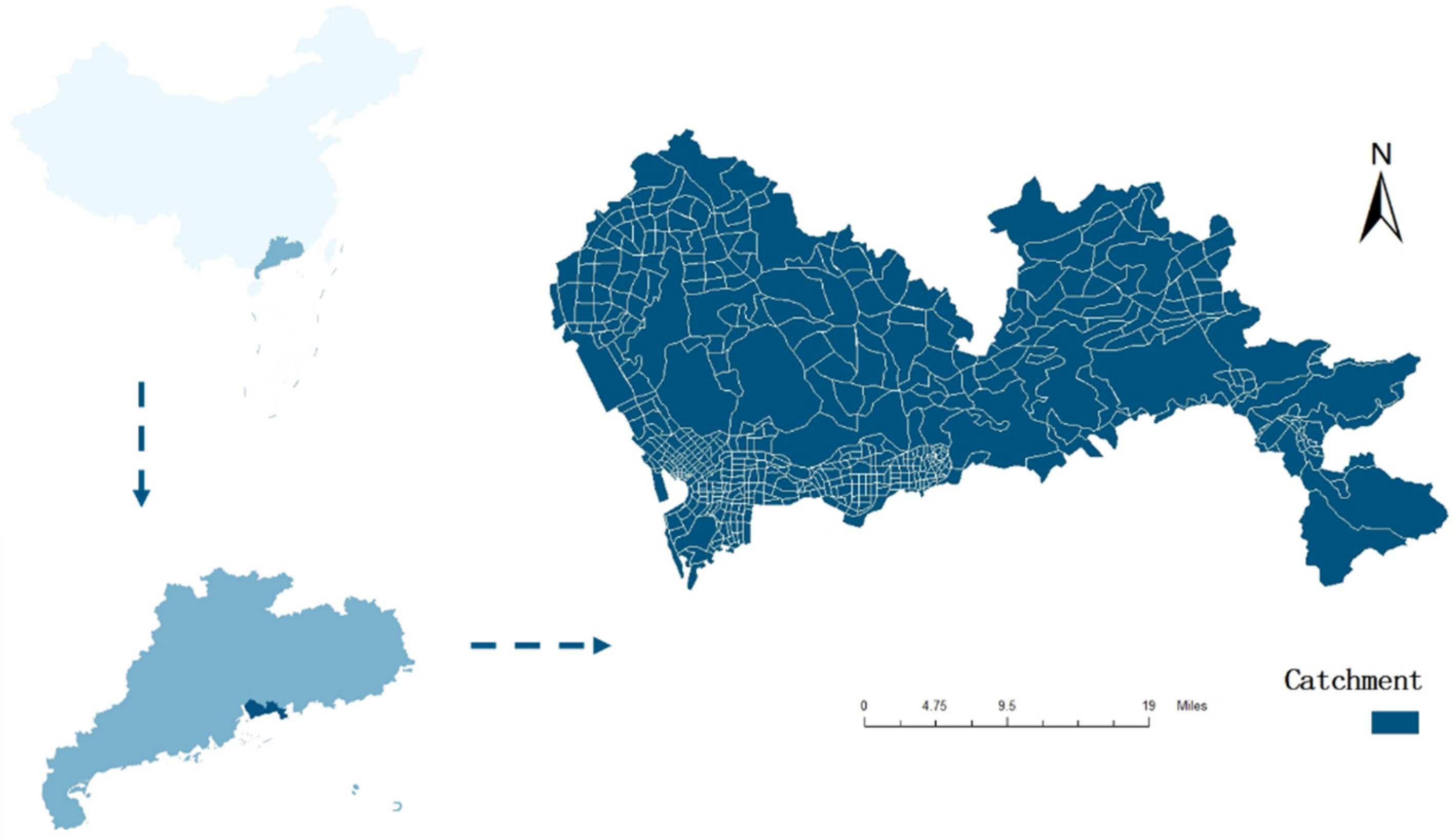
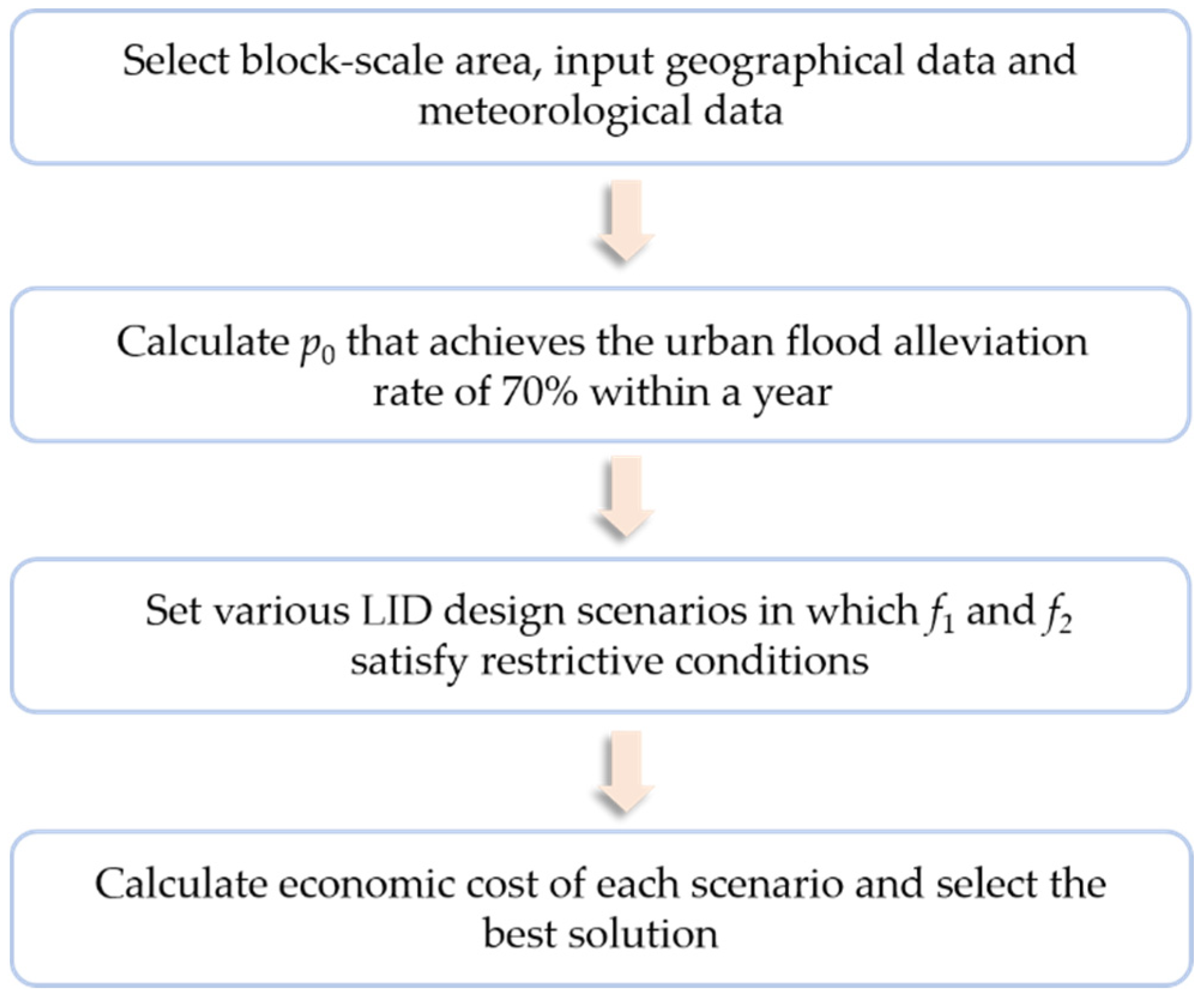
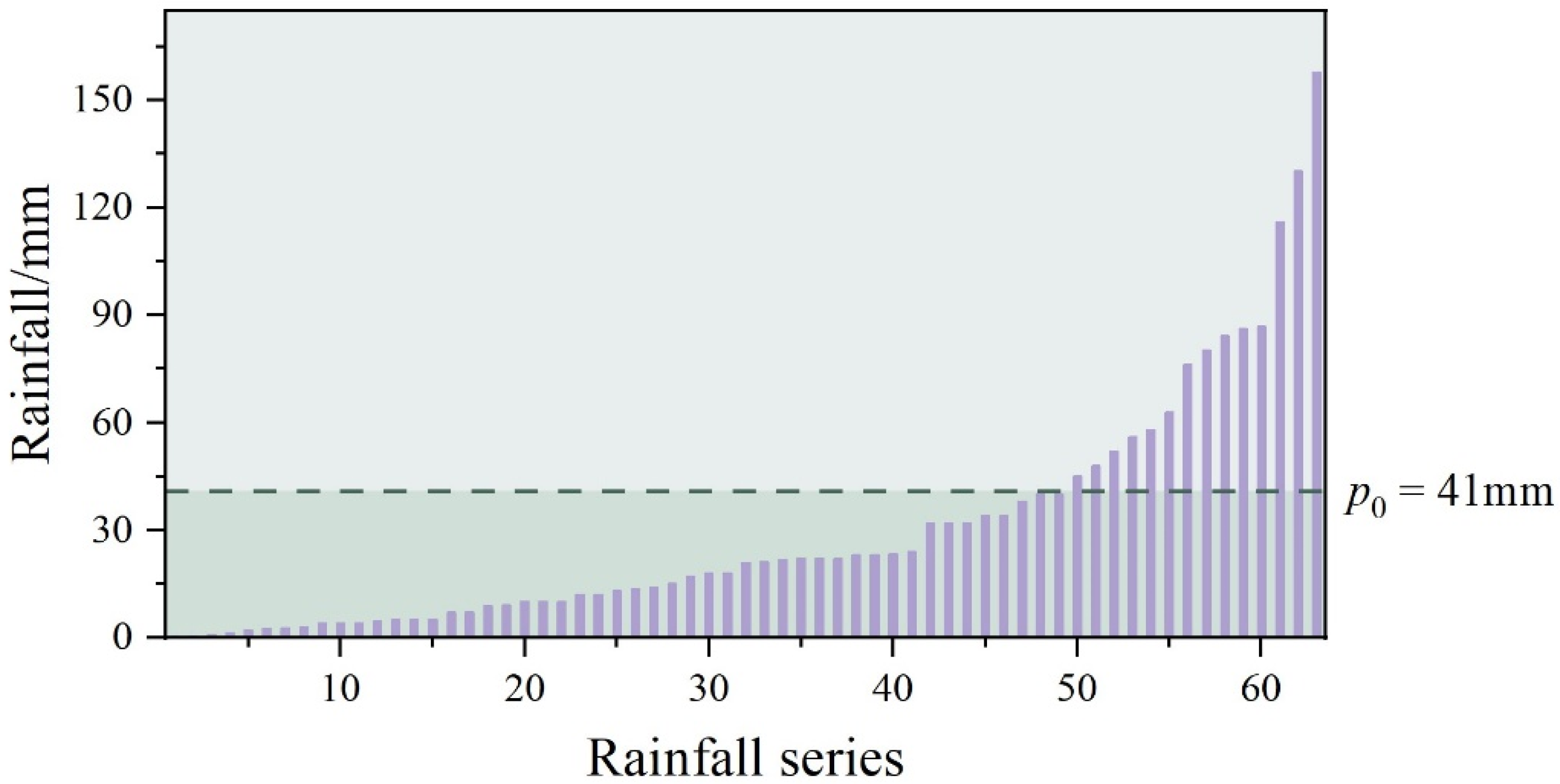
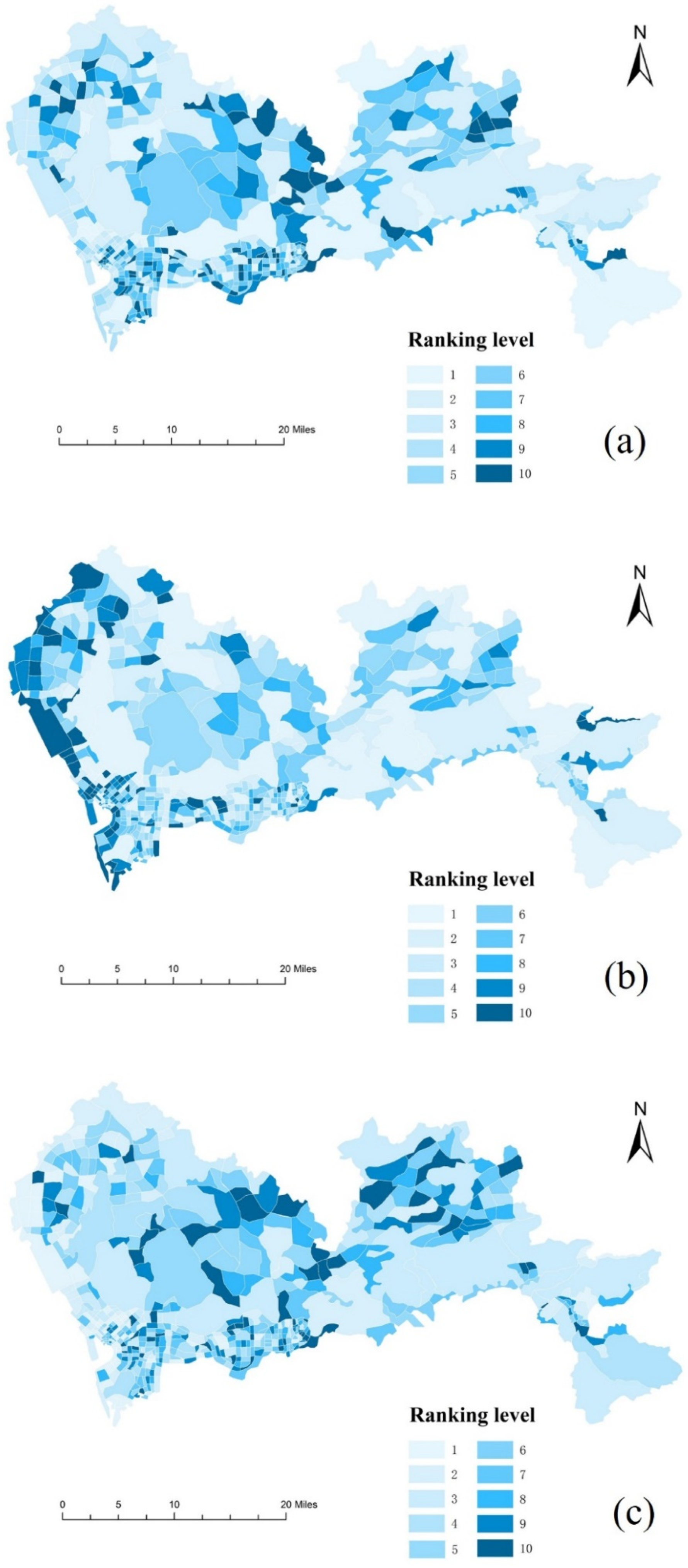
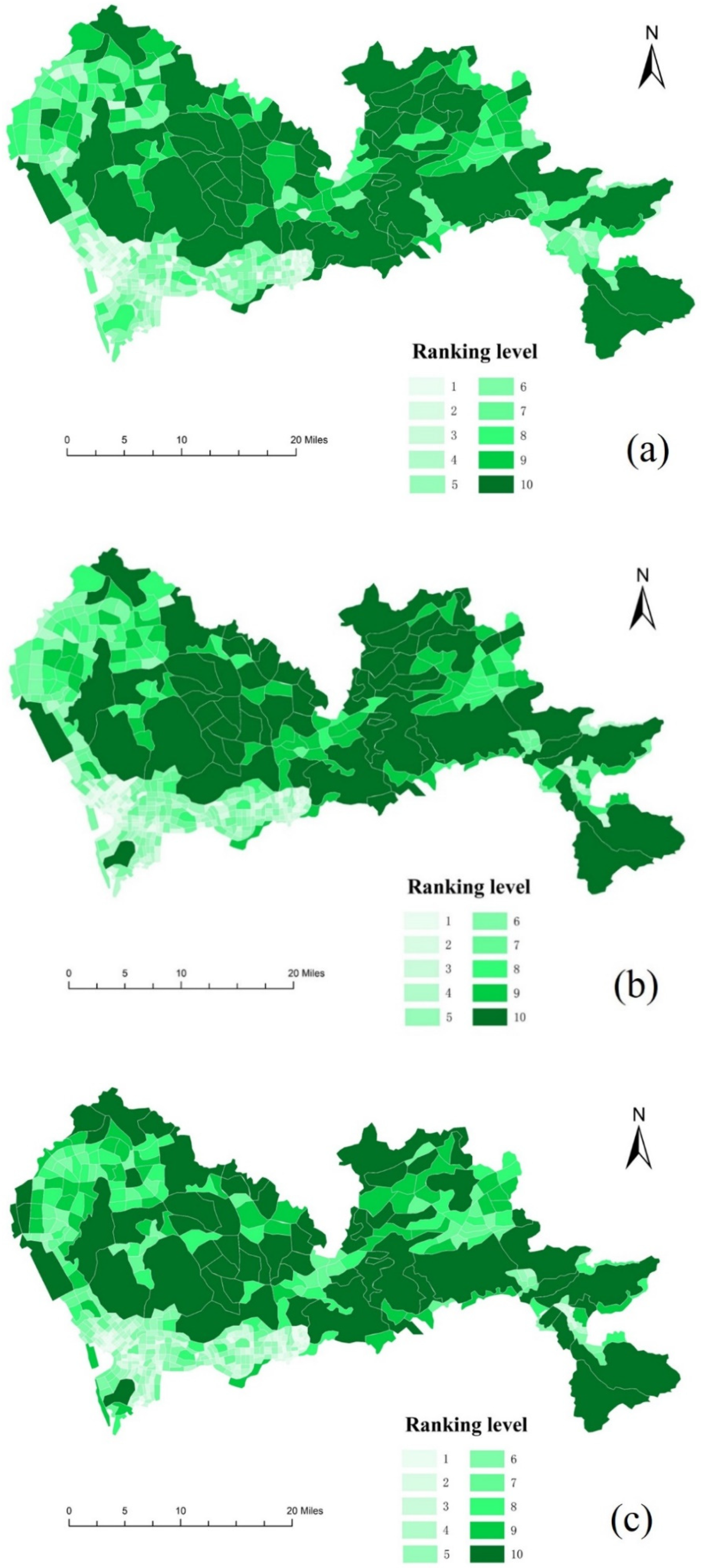
| Landuse Type | Water Quantity | Water Quality |
|---|---|---|
| Bare soil | ||
| Grassland | ||
| Gray infrastructure area |
| Scenarios | LID occupied Proportion within Catchment | Economic Cost/USD Billion | ||
|---|---|---|---|---|
| BS Catchment | GS Catchment | GI Catchment | ||
| 1 | 64%~66% | 14%~16% | 2.5%~3.5% | 22.47 |
| 2 | 74%~76% | 11%~13% | 1.5%~2.5% | 21.14 |
| 3 | 69%~71% | 9%~11% | 4.5%~5.5% | 21.26 |
| Catchment Type | BS Catchment | GS Catchment | GI Catchment |
|---|---|---|---|
| Total area/km2 | 221.84 | 1073.19 | 991.11 |
| Area percentage of all catchments/% | 9.71 | 46.94 | 43.35 |
| Number of catchments | 94 | 101 | 360 |
Publisher’s Note: MDPI stays neutral with regard to jurisdictional claims in published maps and institutional affiliations. |
© 2022 by the authors. Licensee MDPI, Basel, Switzerland. This article is an open access article distributed under the terms and conditions of the Creative Commons Attribution (CC BY) license (https://creativecommons.org/licenses/by/4.0/).
Share and Cite
Zheng, K.; Guan, Y. A Multiobjective Spatial Optimization Model of LID Based on Catchment Landuse Type. Water 2022, 14, 1944. https://doi.org/10.3390/w14121944
Zheng K, Guan Y. A Multiobjective Spatial Optimization Model of LID Based on Catchment Landuse Type. Water. 2022; 14(12):1944. https://doi.org/10.3390/w14121944
Chicago/Turabian StyleZheng, Kaiyuan, and Yuntao Guan. 2022. "A Multiobjective Spatial Optimization Model of LID Based on Catchment Landuse Type" Water 14, no. 12: 1944. https://doi.org/10.3390/w14121944
APA StyleZheng, K., & Guan, Y. (2022). A Multiobjective Spatial Optimization Model of LID Based on Catchment Landuse Type. Water, 14(12), 1944. https://doi.org/10.3390/w14121944





